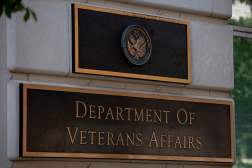House members reprimanded Department of Veterans Affairs officials late Wednesday, accusing the agency of stonewalling the committee’s investigations into mismanagement that may have led to the deaths of dozens of veterans who were on unofficial waiting lists at hospitals and clinics around the country.
Rep. Jeff Miller, R-Fla., chairman of the House Veterans Affairs Committee, accused VA officials of engaging in a “pattern of stonewalling,” during a hearing that lasted late into the night. Miller said it takes “repeated requests and threats of compulsion” to get VA to appear before the committee to answer questions and provide documents.
“Until VA understands that we’re deadly serious, you can expect us to be over your shoulder every single day,” Miller said.
The hearing came just hours after the VA inspector general issued an interim report on its investigation into scheduling practices at VA medical facilities in Phoenix, Ariz. The report highlights systemic flaws dating back to 2002 in the Veterans Integrated System Technology Architecture, VA’s main electronic health record system, known as VistA.
“Ad hoc,” written waiting lists of new veteran enrollees to be entered in the scheduling system were known to exist as early as 2002, according to the IG’s report. During its review of waiting list procedures in Phoenix, the IG discovered certain audit and control features of VistA were not enabled.
“This limited [the Veteran’s Health Administration’s] and the OIG’s ability to determine whether any malicious manipulation of the VistA data occurred,” the report states.
FedScoop this week published an exclusive report detailing the security and auditing shortfalls of the VistA system that were known to VA officials within the past year.
Thomas Lynch, an assistant deputy undersecretary for health at the VA, testified that he participated in multiple visits to VA facilities in Phoenix, along with separate teams of “system redesign” specialists, to find out exactly how hospital administrators were managing patient scheduling.
During his two weeks in Phoenix earlier this year, Lynch and his team identified a wait list automatically generated by the VistA scheduling system whenever patients have their appointments canceled.
“This list is created for the purpose of allowing hospital staff to reschedule those appointments,” Lynch said.
Lynch and his team also identified three other documents used in manual fashion to get patients entered back into VistA. Those documents included the New Enrollee Appointment Request, or NEAR list; a request from the emergency department to schedule a consult; and a request to schedule an appointmen generated from calls to the VA Phoenix help line.
Pressed by lawmakers on why such a lists might be destroyed, Lynch said the lists contained patient identifiable information, and once the patients were rescheduled, those lists were “appropriately” destroyed.
“It’s a federal mandate that we cannot keep lists of personally identifiable information once they have served their useful purpose,” Lynch said.
Although Republicans on the committee sought to paint a picture of VA officials using so-called “secret wait lists,” the latest IG report — as well as reports dating back to 2005 detailing similar, if not worse, scheduling problems — shows the manual lists in question were not secret lists. In most cases, the lists were generated automatically by VistA, and officials were required by federal law to destroy them once they served their purpose.
But VistA’s lack of internal security, identity management controls and auditing capabilities, first detailed by FedScoop, remain areas of concern for members of the committee.
“We are attempting to put in place audit tools,” Lynch told the committee. “And clearly if there’s anything that makes those audit tools more effective, we’re going to assure that they are functioning.”
During the George W. Bush administration and the rocky tenure of R. James Nicholson as VA secretary in 2005, VA’s inspector general had identified at least 10,301 veterans placed on informal waiting lists throughout VA. In addition, at the VA medical facility in Washington, D.C., there were more than 2,000 veterans who had received consult referrals from doctors, but had no appointments in the system.
Follow @DanielVerton





